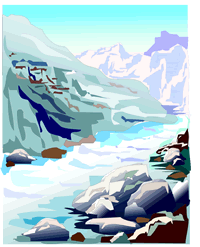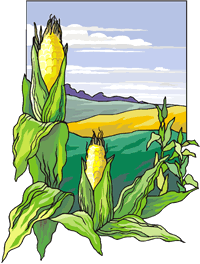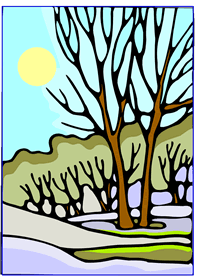Introducing New Hampshire
| Objectives Previewing Activities Post-viewing Activities |
Vocabulary Web Resources |
 View Video |
SUMMARY
 New Hampshire is a land of four seasons, a variety of landforms and regions, a special place in the world. Smaller than other areas, New Hampshire could fit inside Texas 27 times with space left over. All the people of New Hampshire could easily live in the city of Boston. Our tallest peaks cannot compare to the Rocky Mountains.
New Hampshire is a land of four seasons, a variety of landforms and regions, a special place in the world. Smaller than other areas, New Hampshire could fit inside Texas 27 times with space left over. All the people of New Hampshire could easily live in the city of Boston. Our tallest peaks cannot compare to the Rocky Mountains.
Covered By Glaciers
 New Hampshire was shaped long ago, when New England was covered by a glacier. Before then, the mountains were tall and their summits craggy and jagged. The burden of glacial ice and snow upon the land was so great the earth began to sink beneath it. The lowlands sank below the level of the sea and were drowned.
New Hampshire was shaped long ago, when New England was covered by a glacier. Before then, the mountains were tall and their summits craggy and jagged. The burden of glacial ice and snow upon the land was so great the earth began to sink beneath it. The lowlands sank below the level of the sea and were drowned. When the earth tilted back toward the sun, the endless winter began to loosen its grip. The days lengthened and the air grew warmer; the ice and snow began to retreat.
Our great rivers were carved from the waters of the melting glacier. Forests of birch, maple, and white pine sprang up through the rocky soil. Animals sought shelter in the new forests. People came to hunt the animals for food. These native Americans stayed and found ways to work the land so that it would grow their crops. Much later, other people came from across the ocean to fish the sea and use the land. More modern immigrants came to New Hampshire to work and shape the destiny of our state.
Making a Living in NH
 From the very beginning, people have come to New Hampshire to find ways to make their livings. This has not always been easy because of the mountainous terrain and the rocky soil. In the early days, farming was an important industry. The abundance and variety of trees here have made lumbering an important industry. At the end of the 1800s the energy from our swift rivers was used to make power for the mills. The cities became centers of population in New Hampshire, especially on the Merrimack River.
From the very beginning, people have come to New Hampshire to find ways to make their livings. This has not always been easy because of the mountainous terrain and the rocky soil. In the early days, farming was an important industry. The abundance and variety of trees here have made lumbering an important industry. At the end of the 1800s the energy from our swift rivers was used to make power for the mills. The cities became centers of population in New Hampshire, especially on the Merrimack River.
With increased time for leisure, people became more interested in opportunities for recreation. They discovered our 18-mile coastline, the lakes region and the mountains.
Recent Migration
 The most recent migration to New Hampshire has been people from other parts of the United States. These people have come for such reasons as the employment and recreational opportunities, fresh air, and clean water. Many people living in New Hampshire feel that the rapidly-growing population threatens the survival of the very features that make our state so attractive. Other people see this increased migration resulting in more money for the state, as well as providing new ideas for ways to plan for our future.
The most recent migration to New Hampshire has been people from other parts of the United States. These people have come for such reasons as the employment and recreational opportunities, fresh air, and clean water. Many people living in New Hampshire feel that the rapidly-growing population threatens the survival of the very features that make our state so attractive. Other people see this increased migration resulting in more money for the state, as well as providing new ideas for ways to plan for our future.
These changes pose important questions: What is the natural beauty of our state worth to us in terms of progress? What is progress worth in terms of beauty? By taking into consideration all the issues, options, and opinions before making decisions, we can work towards solving our state's problems. We all will have to take the responsibility of letting our government know how we feel on current issues.
In the past, New Hampshire has been affected many times by change--the glacier, the cultivation of the land, the building of towns, the Industrial Revolution. Today New Hampshire is facing many new kinds of change. It is up to us to learn about, appreciate, and take care of our little corner of the world--our New Hampshire.
OBJECTIVES
1. To further introduce students to the area of land known as New Hampshire.
2. To increase understanding of the geographical features and glacial formations of New Hampshire.
3. T5o make students aware of how New Hampshire has changed in the past.
4. To increase awareness of various people and the ways they have come to New Hampshire to earn their livings.
5. To increase student understanding of how our natural resources have affected us and shaped our way of life.
6. To increase awareness of the many recreational opportunities available to us in this state.
7. To increase understanding of New Hampshire's present growth pattern, looking at how this pattern may alter the lifestyle of citizens of the state.
8. To increase awareness and understanding of the decision-making process in relation to issues that affect the citizens of New Hampshire.
9. To encourage active student participation and involvement in learning and caring about the state of New Hampshire.
PRE-VIEWING ACTIVITIES
1. Discuss with the students what New Hampshire means to them.
2. Have students comment on their "way of life" in New Hampshire.
3. Have students make a list of the changes they have noticed within their community in the last few years.
POST-VIEWING ACTIVITIES
1. Compare on map the size of New Hampshire in relation to the size of the United States.
2. On a map of New Hampshire, note the mountainous regions, the rivers, and the coastline.
3. Create a paper model of the mountainous regions of New Hampshire, before and after the glacial period.
4. Select a specific time period and describe how people made or make a living in this state. Comment on the obstacles faced by individuals in attempting to make a living.
5. Make a list of the natural resources in New Hampshire. Beside this list, state how people have benefited from these resources.
6. Plot on a map the migrations to New Hampshire. Indicate the major areas and state the times that people migrated. State various reasons for migration.
7. Research and discuss the issue as to whether New Hampshire should build more superhighways in certain natural areas.
8. Make a list of issues of current interest to the citizens of New Hampshire. Select one issue. Have students make a decision on a plan of action relative to this issue. Have them project the possible impact of this decision on a future generation.
9. Have students write a letter to the editor or appropriate government office relative to a current issue.
10. Discuss the ways in which each citizen can be responsible for our state.
VOCABULARY
|
|
|
WEB RESOURCES
- Geology of NH
- New Hampshire Geology
Learn more about the granite in the Granite State at this site from Moultonborough Central School teacher Daniel E. Reidy at this site he created as part of his Christa McAuliffe Sabbatical Fellowship.